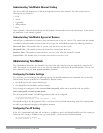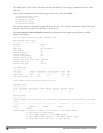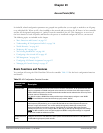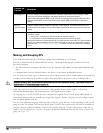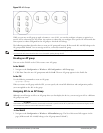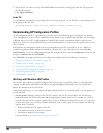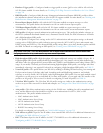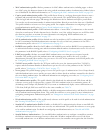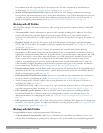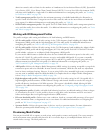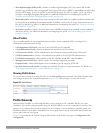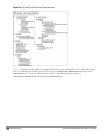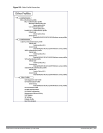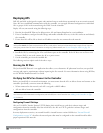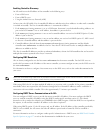
398 | AccessPoints(APs) DellPowerConnectW-SeriesArubaOS6.2 | User Guide
l MAC authentication profile—Defines parameters for MAC address authentication, including upper- or lower-
case MAC string, the diameter format in the string, and the maximum number of authentication failures before a
user is blacklisted. For additional information, see "Configuring the MAC Authentication Profile" on page 189.
l Captive portal authentication profile—This profile directs clients to a web page that requires them to enter a
username and password before being granted access to the network. This profile defines login wait times, the
URLs for login and welcome pages, and manages the default user role for authenticated captive portal clients.
You can also set the maximum number of authentication failures allowed per user before that user is blacklisted.
This profile includes a reference to a Server group profile. For complete information on configuring a Captive
portal authentication profile, refer to Captive Portal Authentication on page 233.
l WISPR authentication profile—WISPr authentication allows a “smart client” to authenticate on the network
when they roam between Wireless Internet Service Providers, even if the wireless hotspot uses an ISP for which
the client may not have an account. For more information on configuring WISPr authentication, see
"Configuring WISPr Authentication" on page 225.
l 802.1x authentication profile—Defines default user roles for machine or 802.1x authentication, and parameters
for 8021.x termination and failed authentication attempts. For a list of the basic parameters in the 802.1x
authentication profile, refer to 802.1X Authentication on page 192
l RADIUS server profile—Identifies the IP address of a RADIUS server and sets RADIUS server parameters such
as authentication and accounting ports and the maximum allowed number of authentication retries. For a list of
the parameters in the RADIUS profile, refer to "Configuring a RADIUS Server" on page 169
l LDAP server profile—Defines an external LDAP authentication server that processes requests from the
controller. This profile specifies the authentication and accounting ports used by the server, as well as
administrator passwords, filters and keys for server access. For a list of the parameters in the LDAP profile, refer
to "Configuring an LDAP Server" on page 172
l TACACS server profile—Specifies the TCP port used by the server, the timeout period for a TACACS+
request, and the maximum number of allowed retries per user. For a list of the parameters in the TACACS
profile, refer to "Configuring a TACACS+ Server" on page 173
l Server group—This profile manages groups of servers for specific types of authentication. Server Groups identify
individual authentication servers and let you create rules for clients based on attributes returned for the client by
the server during authentication. For additional information on configuring server rules, see "Configuring Server-
Derivation Rules" on page 182
l VPN Authentication profile—This profile identifies the default role for authenticated VPN clients and also
references a server group. It also provides a separate VPN AAA authentication for a terminating remote AP
(default-rap) and a campus AP (default-CAP). If you want to simultaneously deploy various combinations of a
VPN client, RAP-psk, RAP-certs and CAP on the same controller, see Table 76.
l Management authentication profile—Enables or disables management authentication, and identifies the default
role for authenticated management clients. This profile also references a server group. For more information on
configuring a management authentication profile, see "Management Authentication Profile Parameters" on page
634.
l Wired authentication profile—This profile merely references an AAA profile to be used for wired authentication.
See "Securing Wired Clients" on page 672.
l Stateful 802.1x authentication Profile—Enables or disables 802.1x authentication for clients on non-Dell APs,
and defines the default role for those users once they are authenticated. This profile also references a server group
to be used for authentication. For details on configuring stateful authentication, see "Stateful and WISPr
Authentication" on page 221.
l Stateful Kerberos Authentication— Use stateful Kerberos authentication to configure a controller to monitor
the Kerberos authentication messages between a client and a Windows authentication server. If the client
successfully authenticates via an Kerberos authentication server, the controller can recognize that the client has



